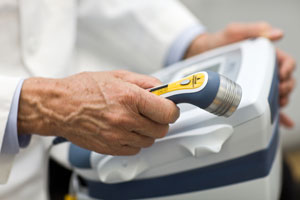Low level laser therapy
Low level laser therapy is the application of laser light over injuries and lesions to stimulate healing within those tissues. Lasers are best known for their ability to cut, but do not confuse Low Level Lasers with cutting or high powered lasers!
Low level lasers, under various names such as cold laser, soft laser, biostimulating laser, photo stimulationdiodes and many others, have been used for over 30 years in many countries as therapeutic energy to bring about favorable biological effects in both animals and humans.
Over 3000 worldwide studies show that LLLT (Low Level Laser Therapy) is totally safe. The Q1000 low level laser is registered with the FDA as a Class I device based on research completed by Underwriters Laboratory (UL). Class I devices present minimal potential for harm to the user, and are generally classified as NSR (non-significant risk) devices. These 3000 studies on the Q1000 laser further verify the safety of LLLT as conducted in worldwide research over the past 30 years.
Please Note: the manufacturer of the laser discussed on this site makes no human claims regarding their products. Lasers shown is intended for veterinary or industrial use.
Laser irradiation of tissue cultures has shown that units of light energy (photons) are absorbed by enzymes which react to light within the cell. Visible red light is absorbed within the mitochondria, and the infrared light is absorbed at the cell membrane. In a mammalian cell, this results in a change in membrane permeability, increased ATP levels and increased DNA production. The photons picked up by the cell membrane result in improved membrane stability and increased activity of the ATP-dependent Na/K pump. Because cell metabolism is influenced by Na/K movement across the membrane, increasing the gradient will affect the flow of ions and hence the overall metabolism of the cell.
On a tissue level, it has been shown that irradiation by laser light results in increased collagen and epithelial production and production of new capillaries and an increase in density of the capillary bed. Reductions in scar tissue formation and keloidadhesions also occur. A reduction of pain and inflammation results from this treatment, as does the stimulation of nerve regeneration, muscle relaxation and atonicity (lack of muscle tone). There is also an indication that laser light therapy helps to increase the immune system response. (From Low Level Laser Therapy Provides New Treatment Possibilities, Dr. Melyni Worth, Ph.D., World Equine Veterinary Review, Vol. 3, No. 3, 1998).
Red light aids in the production of ATP in cells which increases cellular health and energy. The radiation (energy) in normal cells stimulates adjacent cells to divide in the normal process of regeneration and healing. Laser light stimulates abnormal tissue to activate normal intercellular radiation, thus stimulating the normal healing process to start again. The photons produced by laser light normalize tissue by activating enzymes within cells. One activated enzyme within a cell triggers a chemical reaction in which more enzymes are activated in a domino-type effect. Low level laser therapy has no effect on normal tissue. Photons will only be absorbed by cells that need them. (From the Holistic Bird Newsletter (www.holisticbird.com/HBN01/decjan/pages/laser.htm)
According to Low Level Laser Therapy by Jan Turner & Lars Hode (Prima Books), low level laser therapy:
Reduces pain by causing the production of natural pain killers – endorphins
Reduces inflammation by suppressing inflammatory enzymes that create swelling, redness, pain, and heat and enhances the release of anti inflammatory enzymes
Enhances lymphatic drainage, which increases circulation and speeds healing
Stimulates the release of helpful healing enzymes
Releases tight muscles (both smooth and striated) that create chronic pain, joint problems, and decreased mobility
Speeds bone repair by stimulating fibroblastic and osteopathic proliferation.
LLLT in the correct frequency appears to be antiviral, anti fungal, and antiseptic
This horse received a deep wire cut. Due to the severity of the wound, the vet recommended putting the horse down. With only 7-8 treatments of the infected granulation tissue, the wound closed rapidly. With just three more laser treatments, hair grew in the scar tissue!
In Europe, where laser treatment is a well-accepted methodology, it has been used for treatment of traumatic, inflammatory and overuse injuries, pain relief and healing of arthritic lesions, reduction of abscesses, and treatment of persistent non-healing wounds such as cold sores and ulcers. This type of therapy has also been used to prevent or minimize keloid formation, scars and adhesions, to reduce edema, and to reduce pain from surgery and other treatments. Use of low level laser therapy can also encourage the formation of collagen (which can reduce wrinkles) and also cartilage in damaged joints and the repair of tendons and ligaments. In addition, laser light can be used to stimulate acupuncture points in a noninvasive, pain-free manner. (From Low Level Laser Therapy Provides New Treatment Possibilities, Dr. Melyni Worth, Ph.D., World Equine Veterinary Review, Vol. 3, No. 3, 1998).
Veterinarians have and continue to utilize low level laser therapy for:
Pain Relief
To Reduce Swelling
Control Inflammation
And Speed Healing
and to treat conditions such as:
Acute Tissue Damage
Arthritis Pain and Inflammation
Back Pain/Lameness
Bone Healing
Burns
Joint Problems
Nerve Damage
Swelling
Tendon/Ligament Injury
Additional information on Low Level Lasers is contained in The Beneficial Applications of Low Level Laser Therapy by Dr. Morton Walker (click here for full article).


Leave a Reply
Want to join the discussion?Feel free to contribute!